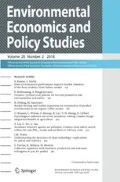Abstract
This study applied the Kuhn-Tucker model to Japanese recreational behavior in neighboring national parks. The results of the application show that local inhabitants attach importance to the satisfactory provision of facilities in each national park. Predictions are made regarding the changes in trip demands that arise with the implementation of hypothetical park management. The prediction results show that there is a spatial substitution effect between national parks, although to a small degree. The results are compared with results based on a repeated discrete choice model. Furthermore, the compensating variations caused by the policies are investigated.
Similar content being viewed by others
References
Department of Environment and Lifestyle, Hokkaido Prefecture (2005) Transition of pertroleum product price (in Japanese), http://www.pref.hokkaido.jp/kseikatu/ks-bssbk/syouhi/bukka/suii.pdf Cited, 20 November, 2005
Doornik JA (2001) Object oriented matrix programming using Ox (4th edn). Timberlake Consultants, London
Feenberg D, Mills E (1980) Measuring the benefit of water pollution abatement. Academic, New York
Hausman JA, Leonard GK, McFadden D (1995) A utility-consistent, combined discrete choice and count data model assessing recreational use losses due to natural resource damage. Journal of Public Economics 56:1–30
Herriges JA, Kling CL, Phaneuf DJ (2004) What’s the use? Welfare estimation from revealed preference models when weak complementarity does not hold. Journal of Environmental Economics and Management 47:55–70
Krinsky I, Robb AL (1986) On approximating the statistics properties of elasticities. Review of Economics and Statistics 68:715–719
Kuriyama K, Hanemann WH (2006) The intertemporal substitution of recreation demand: a dynamic Kuhn-Tucker model with a corner solution. Working paper, School of Political Science and Economics, Waseda University, Tokyo
Kushiro Nature Conservation Office, Ministry of the Environment, Japan (2007) Discussion about appropriate use of Shiretoko national park (in Japanese). http://hokkaido.env.go.jp/kushiro/nature/mat/m_1_2/h18data.html. Cited 11 November, 2007
Mäler KG (1974) Environmental economics. John Hopkins University Press, Baltimore
Morey ER, Rowe DR, Watson M (1993) A repeated nested-logit model of Atlantic salmon fishing. American Journal of Agricultural Economics 75:578–592
Nature Conservation Bureau, Ministry of the Environment, Japan (2005) National Parks (in Japanese). http://www.sizenken.biodic.go.jp/park/info/datalist/. Cited 20 November, 2005
Nature Conservation Bureau, Ministry of the Environment, Japan (2006) Amendment of Natural Parks Law (in Japanese). http://www.env.go.jp/nature/index.html Cited 10 October, 2006
Parsons GR, Jakus PM, Tomasi T (1999) A comparison of welfare estimates from four models for linking seasonal recreational trips to multinomial logit models of site choice. Journal of Environmental Economics and Management 38:143–157
Phaneuf DJ, Sidereslis C (2003) An application of the Kuhn-Tucker demand model to the demand for water trail trips in North Carolina. Marine Resource Economics 18:1–4
Phaneuf DJ, Smith VK (2005) Recreation demands models. In: Mäler KG, Vincent JR (eds) Handbook of environmental economics, vol 2. Elsevier, Amsterdam
Phaneuf DJ, Kling CL, Herriges JA (2000) Estimation and welfare calculation in a generalized corner solution model with an application to recreation demand. Review of Economics and Statistics 82:83–92
Road Transport Bureau, Ministry of Land Infrastructure and Transport, Japan (2005) List of automobile fuel efficiency (in Japanese). http://www.mlit.go.jp/jidosha/nenpi/nenpilist/nenpilist0503.pdf. Cited 20 November, 2005
Road Bureau, Ministry of Land Infrastructure and Transport, Japan (2007) Road traffic census in 2005 fiscal year (in Japanese). Ministry of Land Infrastructure and Transport, Tokyo
von Haefen RA (2007) Empirical strategies for incorporating weak complementarity into consumer demand models. Journal of Environmental Economics and Management 54:15–31
von Haefen RA, Phaneuf DJ (2003) Estimating preferences for outdoor recreation: a comparison of continuous and count data demand system frameworks. Journal of Environmental Economics and Management 45:612–630
von Haefen RA, Phaneuf DJ (2005) Kuhn-Tucker demand system approaches to non-market valuation. In: Scarpa R, Ablerini AA (eds) Applications of simulation method in environmental and resource economics. Springer, Beclin Heidelberg New York
von Haefen RH, Phaneuf DJ, Parsons GR (2004) Estimation and welfare analysis with large demand systems. Journal of Business and Economic Statistics 22:194–205
Wales TJ, Woodland AD (1983) Estimation of consumer demand systems with binding non-negative constraints. Journal of Econometrics 21:263–285
Author information
Authors and Affiliations
About this article
Cite this article
Suwa, T. Estimation of the spatial substitution effect of national park trip demand: an application of the Kuhn-Tucker model. Environ Econ Policy Stud 9, 239–257 (2008). https://doi.org/10.1007/BF03354010
Received:
Accepted:
Published:
Issue Date:
DOI: https://doi.org/10.1007/BF03354010




